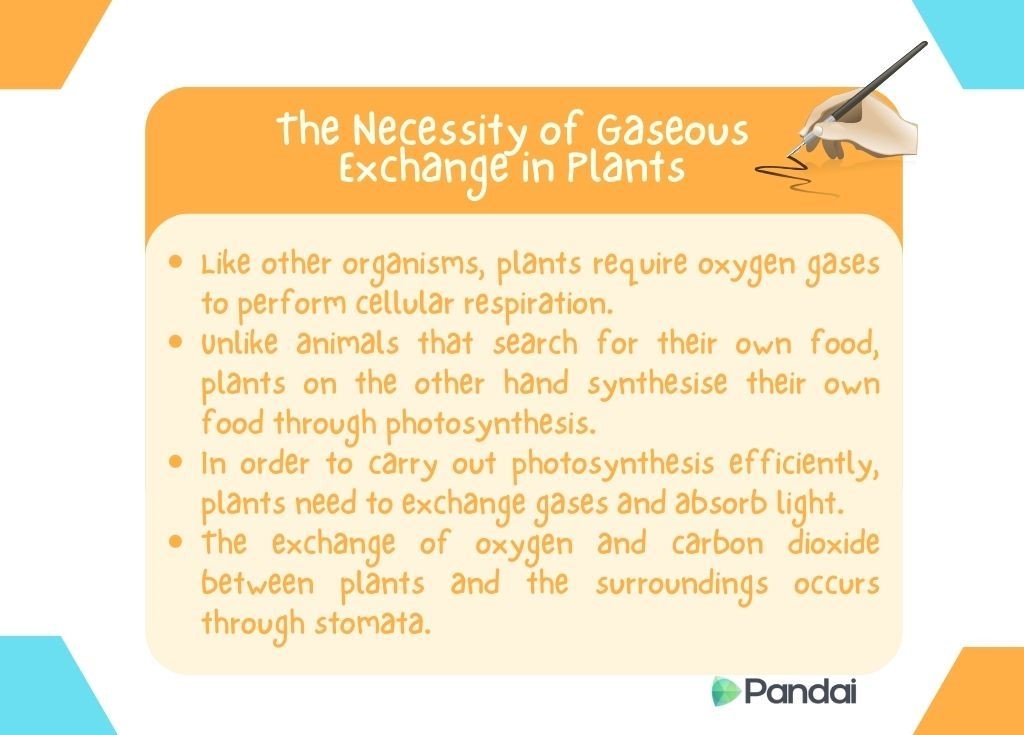| |
| 2.2 |
Main Organ for Gaseous Exchange |
|
| |
 |
| |
| Stomata |
- The pores located on the lower epidermis of the leaf.
- Each stoma is guarded by a pair of guard cells that controls the opening and closing of the stoma by changing their shapes.
- The guard cells contain chloroplasts to carry out photosynthesis.
|
|
| |
| The Mechanism of Stomatal Opening and Closing |
- The mechanism of stomatal opening and closing depends on the conditions of the guard cells whether turgid or flaccid.
- The condition of the guard cells depends on
- The potassium ion (K+ ) uptake by the cells.
- The sucrose concentration in the sap of the guard cells.
|
| Uptake of Potassium Ions by Guard Cells |
- The accumulation or elimination of potassium ion (K+ ) in the guard cells changes the solute potential.
- This increases or decreases the water potential in the guard cells.
- Water is diffused out or into the guard cells through osmosis.
- This condition determines whether the guard cells are turgid or flaccid.
|
| Sucrose Concentration in the Guard Cell Sap |
- During day time or in the presence of light, photosynthesis takes place and produces dissolved sugar (sucrose).
- During night time or in the absence of light, sugar in the guard cells converts into starch.
|
|
| |
| The Opening of Stoma |
| Uptake of Potassium Ions by Guard Cells |
Sucrose Concentration in the Guard Cell Sap |
- The potassium ions enter the guard cells.
- The solute potential in the guard cells increases.
- The water potential in the guard cells decreases.
- The water molecules from the epidermal cells diffuse into the guard cells by osmosis.
- The guard cells become turgid and curve outwards.
- The stoma opens.
|
- In the presence of light, photosynthesis occurs.
- The concentration of sucrose in the guard cells becomes high.
- The water potential in the guard cells decreases.
- The water molecules from the epidermal cells diffuse into the guard cells by osmosis.
- The guard cells become turgid and curve outwards.
- The stoma opens.
|
|
| |
| The Closing of Stoma |
| Uptake of Potassium Ions by Guard Cells |
Sucrose Concentration in the Guard Cell Sap |
- The potassium ions move out from the guard cells.
- The solute potential in the guard cells decreases.
- The water potential in the guard cells increases.
- The water molecules diffuse out from the guard cells to the epidermal cells by osmosis.
- The guard cells become flaccid.
- The stoma closes.
|
- In the absence of light, photosynthesis does not occur.
- The sucrose concentration in the guard cells becomes low.
- The water potential in the guard cells increases.
- The water molecules diffuse out from the guard cells to the epidermal cells by osmosis.
- The guard cells become flaccid.
- The stoma closes.
|
|
| |
| The Effect of Water Deficiency in Plants on Stomatal Opening and Closing |
- Fresh plants:
- When the plant obtains enough water, the guard cells become turgid.
- The inner cell wall of the guard cells is thick and less elastic as compared to the outer cell wall.
- The thin and more elastic outer cell wall causes the guard cells to curve outwards and the stoma to open.
- Wilted plants:
- When the plant lacks water, the guard cells become flaccid.
- The thin and more elastic outer cell wall causes the guard cells to lose turgidity and the stoma to close.
|
|
| |